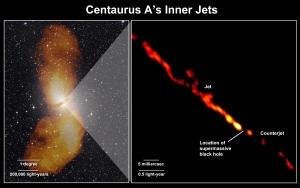In healing, in traditional cultures and in science, death is often a necessary factor in the generation of new life. And oftentimes, the bigger the death, the bigger the growth generated. It seems that death by supermassive black holes might also be a creator of life on galactic scales.

- Orange and blue are jets and radio-emitting lobes emanating from black hole at centre of the galaxy Centaurus A
Throughout millennia, cultures around the globe have celebrated death as much as they have life because, without death, life would not exist. Decomposing trees become nurse logs that nourish new life. Forest fires are hell bent on destruction but they leave behind nourishing soil and seeds for the growth of new life. Winter’s morbid breath allows the earth to rest and to replenish. The Sun burns to help generate life on Earth.
On a personal level, we have to let go of old attachments and allow a part of our being to die when it doesn’t serve us anymore so that we can grow and move forward with our life. The greatest hardships often offer the greatest potential for the biggest leaps in growth.
But the award for the biggest death generating the biggest growth has to be given to supermassive black holes. Black holes are popularly known as the embodiment of death in space, and so it’s puzzling that almost every galaxy has a supermassive black hole smack dab in its centre. More puzzling still, and seemingly contradictory, is the fact that galaxies that birth the most stars seem to harbour the biggest black holes.

- Jet of highly energetic particles from a supermassive black hole (on the right) in the centre of the galaxy Centaurus A (on the left)
Research by a group of astronomers from the European Southern Observatory (ESO) in 2009 reached the extraordinary conclusion that the bigger the black hole, the more stellar life it generates. Supermassive black holes have jets or quasars that spew highly energetic particles, which are basically the transformed remains of whatever the holes’ intense gravity has chewed up. (Black hole vomit?) The quasar’s injection of highly energized matter and energy into the galaxy might be inducing the formation of stars. Astronomer David Elbaz stated that “Our study suggests that supermassive black holes can trigger the formation of stars, thus ‘building’ their own host galaxies. This link could also explain why galaxies hosting larger black holes have more stars.”
New research from ESO and Oxford that is even more radical—and controversial—used basic equations from evolutionary genetics to explain how the universe seems designed for the purpose of… what else… making black holes. This research builds on the concept of “cosmological natural selection” (CNS) first put forward in the 1990s to explain the apparent fine-tuning of the universe’s basic parameters to allow for the existence of atoms, galaxies and life itself. CNS proposes that, if new universes are born inside black holes, a “multiverse” of many possible universes could be shaped by a process similar to natural selection so that successive generations of universes evolve to become better at making black holes.

- Beautiful animation of black hole jets creating a galaxy, like a giant wand doing its magic! http://www.eso.org/public/news/eso0946/
This crazy theory might make sense if the production of better black holes results in the production of more and better stellar life. More universes producing more black holes producing more stars producing more planets producing more life forms producing more thoughts producing more universes…
I’ll be writing more about these (potential) incredible discoveries and how they relate to healing and growth.
SOURCES
Daily Galaxy. Universes Evolve Inside Black Holes–Radical Theories from ESO and Oxford. Published online May 6, 2013. Accessed May 6, 2013. http://www.dailygalaxy.com/my_weblog/2013/05/universes-evolve-inside-black-holes-new-theories-from-eso-and-oxford-.html
European Southern Observatory. Black Hole Caught Zapping Galaxy into Existence? Press release published online on 30 November 2009. Accessed May 8, 2013. http://www.eso.org/public/news/eso0946/
Gardner, A. and Conlon, J. P. (2013), Cosmological natural selection and the purpose of the universe. Complexity. doi: 10.1002/cplx.21446. Abstract accessed on May 6, 2013. http://onlinelibrary.wiley.com/doi/10.1002/cplx.21446/abstract
Oxford University. Did the universe evolve to make black holes? Press release published online on May 4, 2013. Accessed on May 8, 2013. http://www.ox.ac.uk/media/news_stories/2013/130504.html
More information about quasars and black holes:
- http://imagine.gsfc.nasa.gov/docs/ask_astro/answers/960905.html
- http://imagine.gsfc.nasa.gov/docs/science/know_l1/active_galaxies.html
- http://science.nasa.gov/astrophysics/focus-areas/black-holes/
- http://www.nasa.gov/topics/universe/features/radio-particle-jets.html
- http://www.spitzer.caltech.edu/images/5243-sig12-010-An-Artist-s-View-of-the-Heart-of-a-Quasar
- Check out the biggest known object in the universe, a quasar cluster: http://news.nationalgeographic.com/news/2013/01/130111-quasar-biggest-thing-universe-science-space-evolution/
Excellent video and photos of black hole jets in the galaxy Centaurus A: http://svs.gsfc.nasa.gov/vis/a010000/a010700/a010770/

Pingback: Richard Wagamese Workshop for Fearless Creation | Touchy Subjects